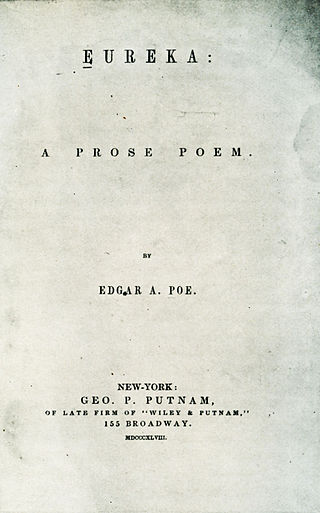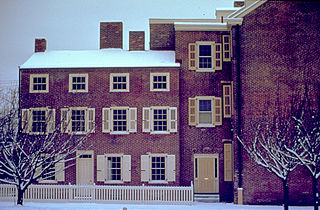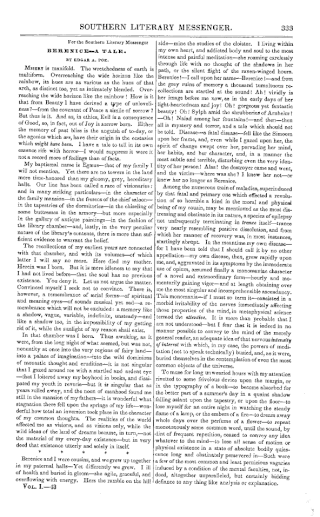
"Lenore" is a poem by the American author Edgar Allan Poe. It began as a different poem, "A Paean", and was not published as "Lenore" until 1843.

"Lenore" is a poem by the American author Edgar Allan Poe. It began as a different poem, "A Paean", and was not published as "Lenore" until 1843.
The poem discusses proper decorum in the wake of the death of a young woman, described as "the queenliest dead that ever died so young". The poem concludes: "No dirge shall I upraise,/ But waft the angel on her flight with a paean of old days!" Lenore's fiancé, Guy de Vere, finds it inappropriate to "mourn" the dead; rather, one should celebrate their ascension to a new world. Unlike most of Poe's poems relating to dying women, "Lenore" implies the possibility of meeting in paradise. [1]
The poem may have been Poe's way of dealing with the illness of his wife Virginia. The dead woman's name, however, may have been a reference to Poe's recently dead brother, William Henry Leonard Poe. [2] Poetically, the name Lenore emphasizes the letter "L" sound, a frequent device in Poe's female characters including "Annabel Lee", "Eulalie", and "Ulalume". [3]
The poem was first published as part of an early collection in 1831 under the title "A Pæan". This early version was only 11 quatrains and the lines were spoken by a bereaved husband. The name "Lenore" was not included; it was not added until it was published as "Lenore" in February 1843 in The Pioneer, a periodical published by the poet and critic James Russell Lowell. Poe was paid $10 for this publication. [4] The poem had many revisions in Poe's lifetime. Its final form was published in the August 16, 1845, issue of the Broadway Journal while Poe was its editor. [5]
The original version of the poem is so dissimilar from "Lenore" that it is often considered an entirely different poem. Both are usually collected separately in anthologies. [6]

"The Raven" is a narrative poem by American writer Edgar Allan Poe. First published in January 1845, the poem is often noted for its musicality, stylized language, and supernatural atmosphere. It tells of a distraught lover who is paid a mysterious visit by a talking raven. The lover, often identified as a student, is lamenting the loss of his love, Lenore. Sitting on a bust of Pallas, the raven seems to further antagonize the protagonist with its constant repetition of the word "Nevermore". The poem makes use of folk, mythological, religious, and classical references.

"Annabel Lee" is the last complete poem composed by American author Edgar Allan Poe. Like many of Poe's poems, it explores the theme of the death of a beautiful woman. The narrator, who fell in love with Annabel Lee when they were young, has a love for her so strong that even angels are envious. He retains his love for her after her death. There has been debate over who, if anyone, was the inspiration for "Annabel Lee". Though many women have been suggested, Poe's wife Virginia Eliza Clemm Poe is one of the more credible candidates. Written in 1849, it was not published until shortly after Poe's death that same year.

"Ulalume" is a poem written by Edgar Allan Poe in 1847. Much like a few of Poe's other poems, "Ulalume" focuses on the narrator's loss of his beloved due to her death. Poe originally wrote the poem as an elocution piece and, as such, the poem is known for its focus on sound. Additionally, it makes many allusions, especially to mythology, and the identity of Ulalume herself, if a real person, has been a subject of debate.

"The Philosophy of Composition" is an 1846 essay written by American writer Edgar Allan Poe that elucidates a theory about how good writers write when they write well. He concludes that length, "unity of effect" and a logical method are important considerations for good writing. He also makes the assertion that "the death... of a beautiful woman" is "unquestionably the most poetical topic in the world". Poe uses the composition of his own poem "The Raven" as an example. The essay first appeared in the April 1846 issue of Graham's Magazine. It is uncertain if it is an authentic portrayal of Poe's own method.

"Al Aaraaf" is an early poem by American writer Edgar Allan Poe, first published in 1829. It tells of the afterlife in a place called Al Aaraaf, inspired by A'raf as described in the Quran. At 422 lines, it is Poe's longest poem.
"The Light-House" is the unofficial title of the last work written by Edgar Allan Poe. He did not live to finish it, and had barely begun it by the time of his death in 1849.

Eureka (1848) is a lengthy non-fiction work by American author Edgar Allan Poe (1809–1849) which he subtitled "A Prose Poem", though it has also been subtitled "An Essay on the Material and Spiritual Universe". Adapted from a lecture he had presented, Eureka describes Poe's intuitive conception of the nature of the universe, with no antecedent scientific work done to reach his conclusions. He also discusses man's relationship with God, whom he compares to an author. Eureka is dedicated to the German naturalist and explorer Alexander von Humboldt (1769–1859).

The Edgar Allan Poe National Historic Site is a preserved home once rented by American author Edgar Allan Poe, located at 532 N. 7th Street, in the Spring Garden neighborhood of Philadelphia, Pennsylvania. Though Poe lived in many houses over several years in Philadelphia, it is the only one which still survives. It was designated a National Historic Landmark in 1962.

"Berenice" is a short horror story by American writer Edgar Allan Poe, first published in the Southern Literary Messenger in 1835. The story is narrated by Egaeus, who is preparing to marry his cousin Berenice. He tends to fall into periods of intense focus, during which he seems to separate himself from the outside world. Berenice begins to deteriorate from an unnamed disease until only her teeth remain healthy. Egaeus obsesses over them. When Berenice is buried, he continues to contemplate her teeth. One day, he awakens with an uneasy feeling from a trance-like state and hears screams. A servant reports that Berenice's grave has been disturbed, and she is still alive. Beside Egaeus is a shovel, a poem about "visiting the grave of my beloved", and a box containing 32 teeth.

Sarah Elmira Shelton was an adolescent sweetheart of Edgar Allan Poe who became engaged to him shortly before his death in 1849.

Sarah Helen Power Whitman was an American poet, essayist, transcendentalist, spiritualist and a romantic interest of Edgar Allan Poe.

Graham's Magazine was a nineteenth-century periodical based in Philadelphia established by George Rex Graham and published from 1840 to 1858. It was alternatively referred to as Graham's Lady's and Gentleman's Magazine, Graham's Magazine of Literature and Art, Graham's American Monthly Magazine of Literature and Art, and Graham's Illustrated Magazine of Literature, Romance, Art, and Fashion.
The Broadway Journal was a short-lived New York City-based newspaper founded by Charles Frederick Briggs and John Bisco in 1844 and was published from January 1845 to January 1846. In its first year, the publication was bought by Edgar Allan Poe, becoming the only periodical he ever owned, though it failed after only a few months under his leadership.

"Eulalie", or "Eulalie — A Song", is a poem by Edgar Allan Poe, first published in the July 1845 issue of The American Review and reprinted shortly thereafter in the August 9, 1845 issue of the Broadway Journal.
This article lists all known poems by American author and critic Edgar Allan Poe, listed alphabetically with the date of their authorship in parentheses.

The American Review, alternatively known as The American Review: A Whig Journal and The American Whig Review, was a New York City-based monthly periodical that published from 1844 to 1852. Published by Wiley and Putnam, it was edited by George H. Colton, and after his death, beginning with Volume 7, by James Davenport Whelpley. As of Volume 10, July 1849, the proprietors of the journal were Whelpley and John Priestly. The American Review was allied to the Whig Party
"The Philosophy of Furniture" is an essay written by American author Edgar Allan Poe and published in 1840. The essay is an unusual work by Poe, whose better-known works include horror tales like "The Tell-Tale Heart". The essay presents Poe's theories on interior decorating.

Thomas Dunn English was an American Democratic Party politician from New Jersey who represented the state's 6th congressional district in the House of Representatives from 1891 to 1895. He was also a published author and songwriter, who had a bitter feud with Edgar Allan Poe. Along with Waitman T. Barbe and Danske Dandridge, English was considered a major West Virginia poet of the mid 19th century.
William Henry Leonard Poe, often referred to as Henry Poe, was an American sailor, amateur poet and the older brother of Edgar Allan Poe and Rosalie Poe.
"The Duc de L'Omelette" is a humorous short story by American writer Edgar Allan Poe. It was first published in the Philadelphia Saturday Courier on March 3, 1832, and was subsequently revised a number of times by the author.